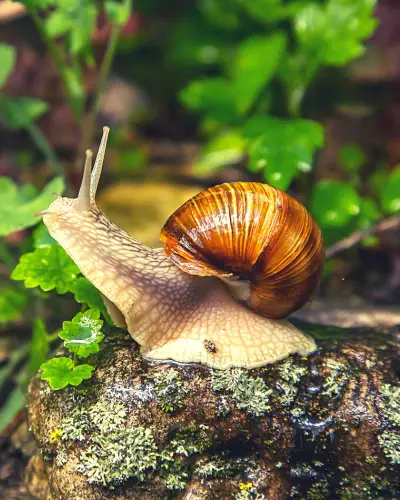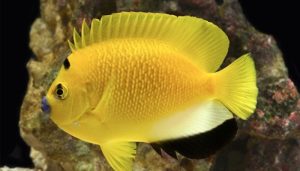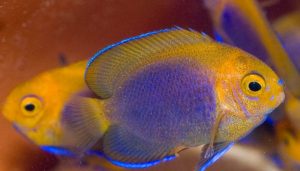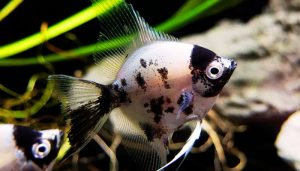Nerite snails are one popular choice for freshwater aquarium enthusiasts due to their peaceful nature and ability to clean algae from tank walls and decorations. These small, colorful snails are a great addition to any tank, but many people need help caring for them properly.
In this comprehensive care guide for nerite snails, we will cover everything you need to know about keeping freshwater snails happy and healthy in your aquarium.
From setting up the perfect environment to understanding their diet and reproduction habits, this guide has got you covered.

Whether you’re a beginner or a seasoned aquarium owner, there’s always something new to learn about these fascinating creatures.
With the correct information and a little care, you can provide a thriving and beautiful home for your snails. So, grab your notebook and get ready to become a snail expert!
Table of Contents
ToggleWhat are Nerite Snails?
Zebra Nerite snails are small, freshwater, or saltwater tank snails popular in aquariums for their algae-eating abilities and attractive shells. They are widely distributed worldwide in tropical and subtropical regions, often found in streams, rivers, and coastal areas.
They are known for their peaceful nature and low maintenance, making them a great addition to a community aquarium. They are also famous for their ability to clean algae off of aquarium plants, decorations, and glass within the aquarium.
These snails come in various colors and patterns, including black, brown, and yellow, with stripes or spots on their shells. With proper care and a suitable environment, nerite zebra snails can thrive and provide practical and aesthetic benefits to their aquarium habitats.
Types Of Nerite Snails For Freshwater Tanks
Nerite snails are popular freshwater aquatic snails known for their algae-eating abilities and beautiful shell patterns. They are peaceful and relatively low-maintenance, making them a good choice for both beginner and experienced aquarists.
Here are some of the most popular species of nerite snail for fresh water tanks:
- Zebra Nerite Snail (Neritina natalensis): This is the most common type of nerite snail, easily recognizable by its black and white zebra stripes. Zebra nerites are hardy and easy to care for, making them a good idea for beginners. They can grow up to 1 inch in diameter, and their lifespan is about 2-3 years.
- Tiger Nerite Snail (Vittina Semiconica): This snail has a beautiful shell with yellow and brown stripes or spots. Tiger nerite snails are also hardy and easy to care for, but they can be more expensive than zebra nerite snails. They can grow up to 1 inch in diameter, and their lifespan is about 2-3 years.
- Olive Nerite Snail (Neritina turrita): The zebra snail has a smooth, olive-colored shell. Olive snails are not as common as zebra or tiger nerite snails, but they are still relatively easy to find. They are also hardy and easy to care for; they can grow up to 1 inch in diameter. Their lifespan is about 2-3 years.
- Black Racer Nerite Snail (Neritina juttingae): This nerite snail has a black shell with yellow stripes. Black racer nerites are not as common as zebra or tiger snails, but they are still relatively easy to find. They are also hardy and easy to care for, growing up to 1 inch in diameter. Their lifespan is about 2-3 years.
- Red Racer Nerite Snail (Neritina ocellata): This snail has a red shell with yellow stripes. Red racer nerite snails are not as common as zebra or tiger nerites, but they are still relatively easy to find. They are also hardy and easy to care for, growing up to 1 inch in diameter. Their lifespan is about 2-3 years.
- Horned Nerite Snail (Nerita albicilla): This snail species has a unique shell with two horns. Horned nerite snails can be more difficult to find than other types of nerite snails, but they are still relatively easy to care for. They can grow up to 1 inch in diameter, and their lifespan is about 2-3 years.
When choosing a nerite snail for your fresh water tank, it is essential to consider the size of your tank, the water parameters, and the other fish and invertebrates in your tank.
Nerite snails are generally peaceful, but some fish, such as loaches and cichlids, can eat them. They also require a tank with a calcium hardness of at least eight dGH, which is necessary for their shells to grow correctly.
What do Nerite Snails Eat In the Wild and as Pets?
What does nerite snail eat? Nerite snails are herbivores that feed on algae, biofilm, and detritus. They will graze on the surfaces of rocks, glass, and the aquarium substrate to find their food.
In the wild, they can be found in freshwater, brackish water, and marine environments, and their diet may vary slightly depending on their habitat.
In an aquarium setting, it’s essential to provide your Neritidae snails with plenty of natural algae to feed on and supplemental foods like algae wafers or blanched vegetables such as zucchini or cucumber.
They may also eat soft algae found on driftwood or decorations in the tank. It’s crucial to ensure they have enough food to prevent them from starving, as they are not typically known to overeat and can be slow feeders.
What Is A Good Tank Size For Nerites?
The ideal tank size for Nerite snails depends on a few factors, but generally, a 10-gallon tank is the minimum recommended size.
Here’s a more detailed breakdown:
– Nerite Snails Tank size:
- Minimum: 10 gallons
- Ideal: 20 gallons or larger
- Nano tanks: Possible in tanks as small as 2-3 gallons, but water quality must be closely monitored due to the smaller volume.
– Number of snails:
Rule of thumb: One snail per 5 gallons of water. This ensures there’s enough algae for everyone.
- Other tank inhabitants:
If you have other fish or invertebrates competing for food or producing a lot of waste, you may also need a larger tank to accommodate the snails.
Here are some additional things to keep in mind when choosing a tank size for Nerite snails:
- They are prolific algae eaters: They can quickly consume all the algae in a small tank, leaving them hungry.
- These snails are sensitive to poor water quality: A larger tank provides more stability in terms of water parameters.
- These snails can escape from open tanks. Ensure your tank has a secure lid.
Setting Up The Perfect Nerite Snails Aquarium Tank
Setting up the perfect Nerite snail aquarium tank requires careful consideration of the tank size, water parameters, and tankmates. Nerite snails thrive in well-established tanks with stable water conditions, so regularly monitoring and maintaining the water quality is important.
A 10-gallon planted tank is suitable for a small group of Neritidae snails, providing plenty of space to explore and graze on algae. It’s crucial to ensure the tank has a tight-fitting lid to prevent the snails from escaping.
When decorating the tank, opt for smooth rocks and live plants to provide hiding spots and surfaces for algae growth. Additionally, it’s essential to avoid keeping zebra snails with aggressive tankmates that may harass or harm them.
A balanced algae wafers and vegetable diet will ensure the snails remain healthy and active. By carefully setting up the tank and meeting the snails’ specific requirements, you can create an ideal environment for these fascinating aquatic creatures.
Good Nerite Snail Tank Mates
When choosing tank mates for your snails, it’s essential to select compatible species that won’t harm or harass them. Here are some excellent options to consider:
Fish:
- Small tetras: Neon tetras, ember tetras, and harlequin Rasboras are all peaceful schooling fish that get along well with nerite snails.
- Corydoras catfish: These bottom-dwelling catfish are also peaceful and make good tankmates for nerite snails. They’ll help to scavenge for leftover food and stir up the substrate, which can benefit the overall health of your tank.
- Honey gouramis: These colorful fish are known for their peaceful nature and beautiful fins. They’re a good choice for tanks with nerite snails, as they’re unlikely to bother them.
Invertebrates:
- Other snails: Nerite snails can coexist with other snail species, such as mystery snails, ramshorn snails, and trumpet snails. Just be sure to avoid species known to be aggressive or predatory, such as assassin snails.
- Shrimp: Many species of shrimp, such as red cherry shrimp, ghost shrimp, and amano shrimp, are peaceful and make good tank mates for your nerites. They’ll help clean up the waste and debris in your tank.
- Dwarf shrimp: These tiny shrimp are another excellent option for tanks with nerite snails. They’re peaceful and unlikely to bother the snails.
Here are some things to keep in mind when choosing tank mates for your snails:
- Size: Avoid fish that are large enough to eat your snails.
- Temperament: Choose peaceful fish unlikely to harass or nip at the snails.
- Water parameters: Make sure your tank’s water parameters are suitable for both the nerite snails and their tankmates.
- Tank size: Don’t overcrowd your tank. Make sure there’s enough space for all of the inhabitants.
Following these tips, you can choose compatible tank mates to help your snails thrive in your aquarium.
Nerite Snails Freshwater Aquarium Care – Favorite Nano Algae Eater
Nerite snails are a popular aquarium hobby because of their ability to clean algae off of plants, glass, and decorations. These small, hardy snails are a favorite among Nano tank enthusiasts because they are excellent algae eaters and are low maintenance.
They can thrive in various water parameters and do not reproduce in freshwater, making them an excellent option for controlling algae without the risk of overpopulation.
Nerite snails are also known for their attractive shells, which come in various colors and patterns, adding visual interest to the aquarium. To care for Nerite snails, provide plenty of algae for them to graze on and a stable water temperature and pH level.
Keeping the tank clean and providing occasional supplemental feeding with algae wafers or blanched vegetables is also important. With proper care, Nerites can be a valuable addition to any freshwater aquarium, keeping the tank free of unsightly algae.
Note: Many of the Zebra nerite snail’s needs depend on whether they are in salt water or fresh water.
Nerite Snail Eggs & Reproduction: How to Breed Nerite Snails?
Breeding Nerite snails in captivity can be a challenge. Nerite snails are difficult to produce in a home aquarium because they require brackish water to hatch their eggs. The eggs are usually laid in clusters on hard surfaces such as rocks or glass and can be difficult to remove without damaging them.
To breed nerite snails, it is best to start with a group of snails in a well-established aquarium with plenty of algae to eat. Then, gradually increase the salinity of the water to simulate the conditions of their natural habitat.
Once the eggs are laid, they can take anywhere from 2-5 weeks to hatch, depending on the temperature and salinity of the water. After hatching, the larvae must be moved to a separate brackish water tank to continue their development.
Breeding snails requires careful attention to water parameters and patience for the eggs to hatch and the larvae to thrive.
Breeding Nerites in a home aquarium setting is quite challenging, bordering on impossible. While they readily lay eggs in freshwater tanks, these eggs won’t hatch there. Here’s the reason:
The Lifecycle Hiccup:
Nerite snails have a complex lifecycle involving a larval stage requiring brackish water (a mix of fresh and saltwater) for development. Unfortunately, adult Nerites cannot survive in salty water for long periods. This creates a hurdle for home breeders, as mimicking their natural breeding environment is challenging.
What You Can Do:
While successfully raising Nerite zebra snails from egg to adult in a home aquarium is unlikely, there are still some things you can do:
- Maintain a Healthy Environment: Provide your snails with clean, well-maintained fresh water with plenty of algae growth (their primary food source). This encourages them to lay eggs, even though they won’t hatch.
- Observe Egg-Laying: If you see eggs in your tank, observe them. You might learn interesting things about their behavior, even if hatching isn’t possible.
- Consider Alternatives: If you’re interested in breeding snails, explore species that have their entire lifecycle in freshwater, like Mystery Snails or Ramshorn Snails.
Commonly Asked Questions about Freshwater Nerite Snail (FAQs)
Are Nerite snails good for your tank?
Yes, Nerite snails are excellent tank cleaners! They gobble algae, are peaceful, and don’t overpopulate. Just avoid large, aggressive fish that might munch on them.
How long do nerite snails live?
Nerite snails cruise for 1-2 years in a happy tank, with some reaching 3! Keep them healthy with good water and calcium for a longer shell-ebration!
How many Nerite snails should be kept together?
How many Nerite snails per gallon? Stick to 1 snail per 5 gallons of water. More snails mean less algae for each, and too many can strain your tank’s resources.
Are Nerite snails hard to keep?
Nerite snails are easy! They handle a range of water conditions, eat algae, and don’t reproduce in freshwater. Just offer calcium and avoid aggressive fish that might snack on them.
Do I need to feed my Nerite snail?
Maybe! Nerites munch on algae, so you’re good if your tank has plenty. If it’s spotless, offer algae wafers or blanched veggies as a tasty treat.
What to feed nerite snails?
Nerites graze on algae but offer treats like blanched veggies or algae wafers if your tank shines! Avoid copper & keep food fresh.
Can two Nerite snails live together?
Absolutely! Nerites are peaceful and even enjoy the company of another snail buddy. Just make sure your tank has enough algae for both!
How much space do Nerite snails need?
Neritidae Snails need 5 gallons per snail to thrive. But consider more for extra hiding space and grazing area. Aim for 10 gallons for the first and 5 extra per snail!
How many snails can live in a 5-gallon tank?
A 5-gallon tank is suitable for 1 or 2 small snails. Overcrowding can lead to stress and health issues. Ensure proper filtration and maintenance for optimal snail care.
Is too many snails in a tank bad?
Too many snails can be harmful. They stress the ecosystem, deplete food, and their waste worsens water quality. Moderation is key!
How offten do nerite snails lay eggs?
Nerites often lay eggs every few days if conditions are ideal, though the eggs rarely hatch in freshwater aquariums, as they need brackish water for successful development.
Do goldfish eat nerite snails?
Goldfish may occasionally nibble on nerite snails, but they generally do not eat adult snails. However, they may target smaller or baby snails if they fit in their mouths.
Conclusion
In conclusion, caring for Nerite snails can be a rewarding experience for aquarium enthusiasts. Their low maintenance requirements, algae-eating habits, and ability to thrive in various water conditions make them popular for beginner and experienced aquarium hobbyists. Regarding breeding, Nerite snails can reproduce in a freshwater tank, but their larvae require brackish water to survive and develop. Thus, successfully breeding Nerite snails is more challenging and requires additional knowledge and resources.
Overall, providing a suitable environment with plenty of algae for Nerite snails to feed on and maintaining proper water parameters is crucial for their well-being. With good care and conditions, Nerite snails can live for several years in captivity, adding beauty to the aquarium and serving as efficient algae cleaners.
You might also like
- Baby Snails Appeared in My Fish Tank Good OR Bad! (Surprise)
- What Do Nerite Snails Eat: A Comprehensive Care Guide
- Preventing Nerite Snail Egg Clutches in Your Aquarium: 3 Secret Ways
- Horn Nerite Snail 101: A Comprehensive Guide for Beginners
- How Long Can Nerite Snails Live: A Comprehensive Guide
- How Many Snails per Gallon Freshwater: (Find Out the Safe Limit)
- Keeping Betta and Nerite Snail Happy (Expert Tips)
- Nerite Snail Life Expectancy 101: (Longevity Secrets & Care Tips)




